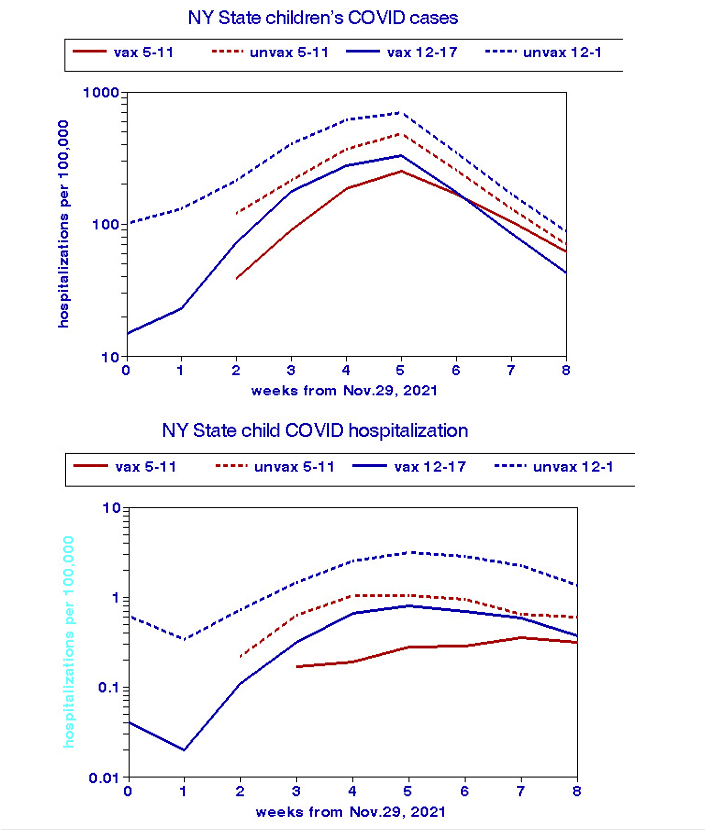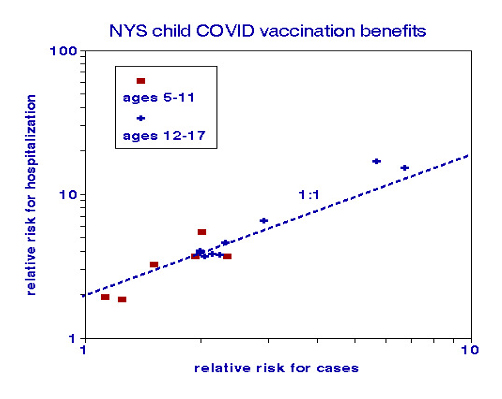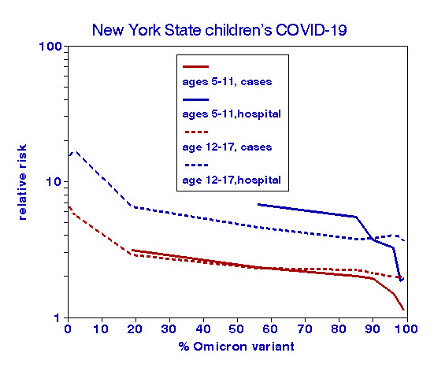The effectiveness of vaccines against COVID infection has been well established. Vaccine coverage has been steadily increasing, concurrently with the spreading of the Omicron virus variant. Recent data on children in New York State provide an opportunity to examine these trends.
“These findings support efforts to increase vaccination coverage in children and adolescents and review dosing strategies…” [1]
New York State data on children ages 5-11 and 12-17 were assembled by linking four databases from December 13, 2021, through January 30, 2022. The outcome measures were new COVID-19 cases (infections) and hospitalizations by vaccination status, evaluated weekly. Here we define the relative risk (RR) of not being vaccinated as the ratio of unvaccinated to vaccinated outcomes; an increased RR thus indicates more effective vaccination.
New hospitalization rates were quite low, < 1%, and vaccination was almost twice as important for hospitalization as for infection. Cases, hospitalizations, and unvaccinated RRs were substantially higher among the adolescents.

Case and hospitalization trends by age group and vaccination status peaked around the Christmas holidays, perhaps due to increased exposures; these trends were not discussed. The vaccinated and unvaccinated trends tended to converge. Concurrently, the Omicron variant began to spread, and vaccination coverage increased among the 5-11 year-olds. The waning of vaccine efficacy (for which we have no data) might also have influenced these trends. We used statistical analysis to examine the interplay between vaccination and the Omicron variant trends.

Our analysis was intended to estimate the importance of age, % vaccination coverage, and % Omicron sequences on the protective value of vaccination in reducing infection or hospitalization, i.e., the relative risks. We found a near-perfect 1:1 relationship between immunization and protection for both age groups - a higher percentage of full vaccination coverage led to greater vaccination protection.

But a higher percentage of the Omicron variant had a more significant and opposite effect on both infections and hospitalization, decreasing the benefits of vaccination nearly 4-fold. But to be clear, vaccination always reduces the risks of childhood COVID infection and hospitalization.
The New York study also looked at waning vaccine efficacy beginning in January 2022. The waning rate was higher for ages 5-11 (~3% per day, 100% after seven weeks) than for ages 12-17 (~1.7% per day, 50% after seven weeks). A national study supported this conclusion.[2]

The study is small by COVID standards but nevertheless involved about 250,000 events. What has been learned?
- Children’s case and hospitalization rates are highly correlated.
- Both peaked during the 2021 winter holiday season for reasons not understood.
- The 12-17 age group had higher hospitalization rates following COVID infection.
- Vaccination played a significant role in reducing COVID infections and hospitalizations in New York State children and adolescents in the winter of 2021-22.
- The Omicron variant tended to substantially reduce the benefits of COVID vaccination in New York’s children.
1] Risk of Infection and Hospitalization Among Vaccinated and Unvaccinated Children and Adolescents in New York After the Emergence of the Omicron Variant. JAMA. DOI: 10.1001/jama.2022.7319.
[2] Association of Prior BNT162b2 COVID-19 Vaccination With Symptomatic SARS-CoV-2 Infection in Children and Adolescents During Omicron Predominance. JAMA. DOI: 10.1001/jama.2022.7493.
